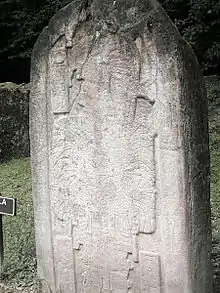Tikal–Calakmul wars
The Tikal–Calakmul wars were a series of wars, mainly between Tikal and Calakmul on the Yucatán Peninsula, but also with vassal states in the Petén Basin such as Copan, Dos Pilas, Naranjo, Sacul, Quiriguá, and briefly Yaxchilan had a role in initiating the first war.
| Tikal–Calakmul Wars | ||||||||
|---|---|---|---|---|---|---|---|---|
_2.JPG.webp) One of the first battles in the war between Bonampak and Yaxchilan is elaborately painted at Bonampak | ||||||||
| ||||||||
| Belligerents | ||||||||
|
Tikal-affiliated city-states: Dos Pilas (until 648) Naranjo others |
Calakmul-affiliated city-states: Naranjo El Zotz El Perú La Corona Dos Pilas (from 648) others |
Third-party factions: others | ||||||
Background
In 537 the Ajaws of Bonampak, Lakamtuun, and Calakmul were captured by Yaxchilan.[1] Bonampak and Lakamtuun remained under the control of Yaxchilan but in retaliation Calakmul conquered the latter. This gave the polity a adventagous strategic position with territory in both the east and the west of Tikal. In numerical terms, however, Calakmul remained inferior to Tikal: Despite being one of the most prosperous Maya cities, Calakmul housed just about 50,000 people,[2] while its entire kingdom had a population of 200,000.[3] In contrast, Tikal was home to almost half a million people.[2] Both city states greatly eclipsed other Mayan polities, and have been described as "superpowers" that led rival power blocs.[4]
First war, 537–572

After conquering Yaxchilan and its subsidiaries, Calakmul allied itself with anti-Tikal cities such as Caracol, El Perú and El Zotz. The latter in particular was located closely to Tikal, and had been opposed to its more powerful neighbor for a long time.[5] The conflict between Tikal, Calakmul and their respective allies resulted in the increasing sophistication of Maya warfare, including the construction of large, well-fortified citadels to protect strategically significant routes. One of the most notable forts, La Cuernavilla, was constructed between Tikal and El Zotz.[6]
Calakmul went on to conquer Naranjo in 546 (9.5.11.11.18 on the Maya calendar). Tikal and its kingdom were not destroyed, but suffered major losses and went into decline after the war ended in 572 (9.6.18.0.14).
"Cold War"
The phrase cold war has been used to describe the time between major conflicts involving Calakmul and Tikal. During these times there was continuous war but no major battles or political changes took place. There were of course minor border skirmishes.
As Tikal gradually regained strength, its local, smaller rivals such as El Zotz declined.[5]
Second war, 650–695
The second war lasted from 650 to 695 (9.10.17.3.3-9.13.2.14.19). One of the main battle grounds of this conflict was Dos Pilas, a city which had been established as military outpost by Tikal. Ruled by B'alaj Chan K'awiil, the brother of Tikal's king, Dos Pilas was overrun by Calakmul after years of heavy combat. B'alaj Chan K'awiil initially fled into exile, but then opted to switch sides and restored his rule of Dos Pilas, this time under Calakmul's dominance. Supported by his new allies, Dos Pilas consequently began a destructive "proxy war" against its old mother city.[4]
B'alaj Chan K'awiil laid claim to the royal title Ajaw and emblem of Tikal ![]()
Third war, 720–744
K'ak' Tiliw Chan Yopaat, Ajaw of Quiriguá was one of the key people during the third war. Quiriguá was a province of Copán, then in 734 K'ak' Tiliw Chan Yopaat lead a revolution against Uaxaclajuun Ub'aah K'awiil, Ajaw of Copán. Wamaw K'awiil, kaloomte (high king, a position higher than ajaw) of Calakmul traveled to Quiriguá and formed an alliance with K'ak' Tiliw Chan Yopaat. Uaxaclajuun Ub'aah K'awiil was executed in 738, and Quiriguá became independent. By 744 El Peru and Naranjo had been reconquered by Tikal, and Calakmul had been defeated.[8]
Aftermath
Having been deprived of its military reputation Calakmul lost its northern provinces and collapsed, the last recorded date in the city was 899, possibly 909. Similarly Tikal, and most of the Maya cities were destroyed in the Maya collapse. The war may have contributed to the collapse, along with overpopulation, disease, famine, and others.
References
- Martin, Simon; Nikolai Grube (2000). Chronicle of the Maya Kings and Queens: Deciphering the Dynasties of the Ancient Maya. London and New York: Thames & Hudson. p. 121. ISBN 0-500-05103-8. OCLC 47358325.
- Braswell, G. E., Gunn, J. D., Domínguez Carrasco, M. R., Folan, W. J., Fletcher, L. A., Morales-López, A., & Glascok, M. D. (2004). "Defining the terminal classic at Calakmul, Campeche. The terminal Classic in the maya lowlands: Collapse, transition, and transformation," 162–194. Braswell et al. 2005, p.171.
- Braswell et al. 2005, p.170.
- Wilford, John Noble (19 September 2002). "Maya Carvings Tell of a War of 2 Superpowers". New York Times. Retrieved 15 February 2020.
- Houston (2008), p. 9.
- Clynes, Tom (1 March 2019). "Lasers reveal Maya war ruins". National Geographic. Retrieved 29 May 2019.
- Mesoweb.com: Second Tikal-Calakmul War
- Martin & Grube 2000, p.114.
Works cited
- Houston, Stephen (2008). "In the Shadow of a Giant: Research at El Zotz, Guatemala" (PDF online publication). Mesoweb articles. Mesoweb: An Exploration of Mesoamerican Cultures.CS1 maint: ref=harv (link)
